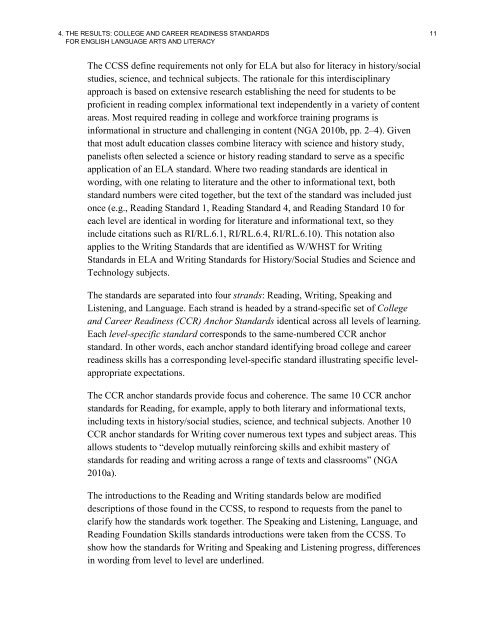CCRStandardsAdultEd
You also want an ePaper? Increase the reach of your titles
YUMPU automatically turns print PDFs into web optimized ePapers that Google loves.
4. THE RESULTS: COLLEGE AND CAREER READINESS STANDARDS 11<br />
FOR ENGLISH LANGUAGE ARTS AND LITERACY<br />
The CCSS define requirements not only for ELA but also for literacy in history/social<br />
studies, science, and technical subjects. The rationale for this interdisciplinary<br />
approach is based on extensive research establishing the need for students to be<br />
proficient in reading complex informational text independently in a variety of content<br />
areas. Most required reading in college and workforce training programs is<br />
informational in structure and challenging in content (NGA 2010b, pp. 2–4). Given<br />
that most adult education classes combine literacy with science and history study,<br />
panelists often selected a science or history reading standard to serve as a specific<br />
application of an ELA standard. Where two reading standards are identical in<br />
wording, with one relating to literature and the other to informational text, both<br />
standard numbers were cited together, but the text of the standard was included just<br />
once (e.g., Reading Standard 1, Reading Standard 4, and Reading Standard 10 for<br />
each level are identical in wording for literature and informational text, so they<br />
include citations such as RI/RL.6.1, RI/RL.6.4, RI/RL.6.10). This notation also<br />
applies to the Writing Standards that are identified as W/WHST for Writing<br />
Standards in ELA and Writing Standards for History/Social Studies and Science and<br />
Technology subjects.<br />
The standards are separated into four strands: Reading, Writing, Speaking and<br />
Listening, and Language. Each strand is headed by a strand-specific set of College<br />
and Career Readiness (CCR) Anchor Standards identical across all levels of learning.<br />
Each level-specific standard corresponds to the same-numbered CCR anchor<br />
standard. In other words, each anchor standard identifying broad college and career<br />
readiness skills has a corresponding level-specific standard illustrating specific levelappropriate<br />
expectations.<br />
The CCR anchor standards provide focus and coherence. The same 10 CCR anchor<br />
standards for Reading, for example, apply to both literary and informational texts,<br />
including texts in history/social studies, science, and technical subjects. Another 10<br />
CCR anchor standards for Writing cover numerous text types and subject areas. This<br />
allows students to “develop mutually reinforcing skills and exhibit mastery of<br />
standards for reading and writing across a range of texts and classrooms” (NGA<br />
2010a).<br />
The introductions to the Reading and Writing standards below are modified<br />
descriptions of those found in the CCSS, to respond to requests from the panel to<br />
clarify how the standards work together. The Speaking and Listening, Language, and<br />
Reading Foundation Skills standards introductions were taken from the CCSS. To<br />
show how the standards for Writing and Speaking and Listening progress, differences<br />
in wording from level to level are underlined.


